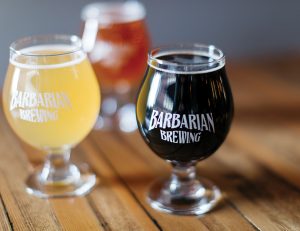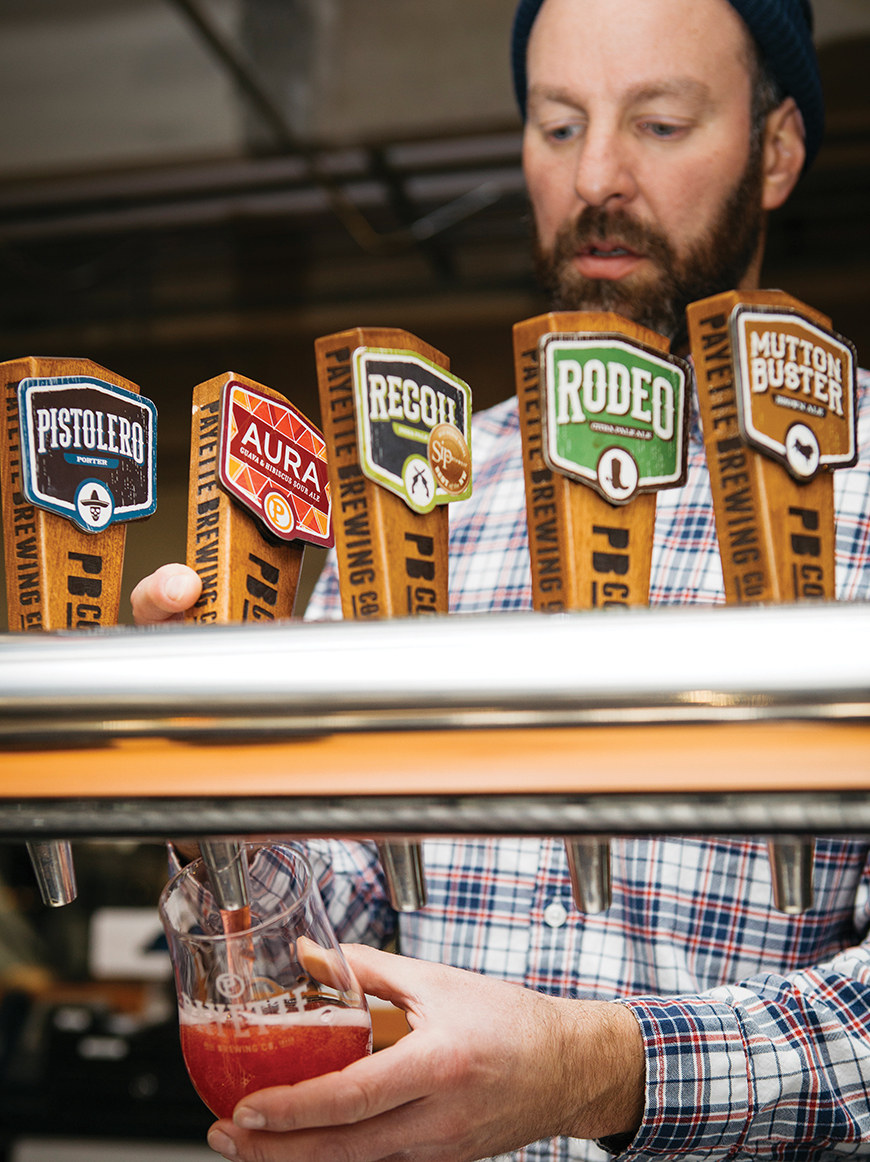Local breweries are producing more sour beers than ever before. Beer drinkers who stuck to their favorite IPA or pale ale in years past are growing more adventurous, sampling beers further down the tap list.
Wild flavors and exotic colors reward them. Payette Brewing offers the Aura, a bright-pink sour infused with guava and hibiscus.
Woodland Empire served its seasonal Peach Party, a gose-style sour featuring peaches and apricots. Then there’s Barbarian Brewing, which has gone all in on sours, dedicating around 10 of its 23 taps at its Downtown location to the tart and funky brews.
Barbarian’s ever-changing sours list has or currently includes:
- It’s Whiskey Mellon Thyme!, a red ale aged for a year in whiskey barrels finished with lemon, thyme and orange flush honeydew melon.
- Funky Sweet Tarts, a golden sour aged in French Pineau des Cherentes aperitif oak barrels.
- Beta Wolf 2.0, a sour IPA aged with mango, passion fruit and tequila
oak staves.
James Long and Bre Hovley, the husband-wife team behind Barbarian, hoped that sours would help differentiate Barbarian from an increasingly crowded Boise craft beer scene when they opened their first location in Garden City in 2015. The couple loved tart beers, Hovely says, and they watched as sours became popular in beer Meccas such as Portland, Seattle, and Denver. But they weren’t sure Boise beer drinkers were ready to get weird.
“Sockeye (Brewing) had dabbled with a few sours, but it wasn’t their focus,” Hovley says. “We knew nobody was focusing on sours, so from the start, that was our goal. But we also knew it would take a few years to get there.”
So they dipped one toe in the water with the original Beta Wolf.

Photo by Ray J. Gadd
It sold, then the next sour sold. By 2018, they were brewing off-the-wall creations like Pop Rocks Gose, infusing salt, Hawaiian Punch juice, guava, mango, passion fruit and Pop Rocks, with some of the famously crackling candy served on top of fresh pours for good measure.
Barbarian’s sours success was part of the owners’ decision to open the Downtown taphouse. With all 100 barrels full of aging beers, the brewery’s Garden City location didn’t have the space or customer volume to drink all of the beer that was on the way. So Long and Hovley moved into the Main Street space that formerly housed the coffee shop Crux, doubling its space and adding more taps than it could offer in Garden City.
India Pale Ales remain Barbarians top seller, and Long, the head brewer, makes sure to have four IPAs on tap. But Hovley says Barbarian, which saw its sales increase roughly 200 percent in 2018, caught on because it established a reputation as Boise’s House of Sours. “It was a longshot gamble,” she says. “Before we went Downtown, people didn’t know we made sours. Now, that’s all they think we make.”
Measuring sour styles’ growth in national popularity is tricky because much of it is happening in taprooms rather than in retail channels, says Bart Watson, chief economist of the Brewers Association. However, retail channels sold 542,000 cases of sour varieties compared to 72,000 in 2014, a whopping 650 percent increase, which begins to tell the sour story, Watson says. (That’s still a drop in the barrel. American IPAs sold 21 million cases.)
Those growing sour retail sales were propelled by big craft breweries launching new beers on the easy drinking side of the tart spectrum, such as Dogfish Head’s Seaquench and Sierra Nevada’s Otra Vez. The stats offer an incomplete snapshot, but Watson says they confirm an obvious trend: consumers are more adventurous than ever.
“Craft drinkers are flavor and variety seeking, looking for different beers for different occasions,” Watson says. “Sours have a wide range of flavors and fit in numerous occasions where other beers may not fit well.”
That’s been the case for Payette, Head Brewer and Production Manager Matt Waterson says. Payette customers used to stick to their go-to beer, such as brewery flagships Rustler IPA. Now, more customers are sampling the entire tap row and are eager to try whatever’s new, including the Aura. Spurred by Aura’s success, Payette plans on brewing four or five sours in 2019 and expanding from kettle brewing, which basically replicates the typical two-week brewing period of most beers, to barrel aging, which can take a full year.
In addition to providing the variety that Boise customers seek today, sours also give brewers a chance to play with local ingredients. Those include huckleberries, which Watterson said would reflect Boise’s connection to the mountains. But the possibilities are endless. “American craft brewers are always looking for ways to separate themselves, to experiment,” Watterson says. “As a brewer, I’m excited. I’m looking forward to where sour beer exploration is going to go.”
HOW SOURS ARE MADE
Most beers, such as porters or pilsners, are more or less brewed with the same techniques and ingredients typical within the style. Sours are not. The ingredients vary wildly and often include botanicals and fruits to add flavor, as well as aging in wine or liquor barrels. Tartness ranges from light to puckering. Some sours are also commonly described as “earthy,” or, “funky.”
The key to souring a beer lies under the microscope. Brettanomyces, a strain of yeast, and lactobacillus, a type of bacteria, are usually considered contaminants for brewers because they—you guessed it—turn brews sour. For sours, they are starmakers.
Sours can be kettle brewed, producing beer in around two weeks, just like most other beers. They can also be barreled for more than a year to add additional flavor and complexity. Some breweries consider sours to be risky because they are more easily contaminated and ruined than other styles. Barrel aging requires investment in barrels, racking space and, of course, time.
Brewers have produced sours for centuries. Each region uses different methods, each with its own name, including lambic, gose, saison, American wild ale, Beliner Weiss and Flanders red ale.

